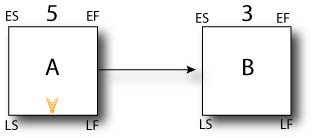
One such resource, which shall rename nameless, has been the source of much confusion on this topic, but never fear – I’ll clear it up for you! In short, your project begins on Day 1, but you can still work out the right answers if you are bent on beginning on Day 0. There are several reasons why Day 1 is preferred, and I’ve tried to address them in this post.
Let’s start by considering the following network fragment:
In this case, Activity A has a duration of 5 units (let’s say days in this case), and Activity B has an estimated duration of 3 days. Now, doing this the straightforward way, the early start of Activity A would be Day 1 and the early finish would be Day 5. This makes sense, but if you begin on Day 0 as some mysteriously advocate, the early finish for Activity A would be Day 4. Either way, if you were given the early start and early finish and asked to calculate the duration, it would be the same approach: EF – ES + 1 (for a more thorough explanation on calculating durations, early start, and early finish, see chapter 6 of The PMP® Exam: How To Pass On Your First Try).
Day 1 just makes more sense. It’s more straightforward, and it’s easier to apply to reality. Now, in order to move the conversation forward, I’ve tried to anticipate a few questions on this topic below. If you still have questions, feel free to add your own in the comments section.
Question: “The way I learned to do PDM (from an outdated project management text) was to begin by using Day 0, but your book teaches that a project starts on Day 1. Which way is correct?”
Answer: Day 1 is correct. For one reason, there is no such thing as Day 0. It’s an abstract concept that adds no value. Day 1 is more closely tied to reality. For that matter, you could pick any number and make the math work, but Day 0 makes no more sense than arbitrarily starting on Day 25.
Question: “Doesn’t PMI advocate one way or the other?”
Answer: No. The 4th Edition PMBOK® Guide deals with PDM very sparsely. In fact, it is only mentioned in Section 6.2.2.1, and indirectly in section 6.2.3.1, but they do not directly address this issue at all. When we made a formal inquiry to PMI on this issue, they responded that they do “not take an official position” on this. Now, there may be people at PMI who have opinions on the matter, but PMI does not hold an official position as of the writing of this post.
Question: So what should I expect to see on the PMP® Exam?
Answer: Ahhhh… this is what everyone really wants to know! You should be prepared to solve the problems either way, using Day 0 or Day 1 (the math is essentially the same); however, since beginning a project on Day 1 represents current best practice and thought, you should really expect that any PDM examples you see use Day 1 as the project’s start date. If it’s unclear in the problem, assume Day 1, and you should be fine.
Question: This is confusing! Why do we have two different ways anyway?
Answer: Take a deep breath. Although it appears confusing, the ways are not that different. The origin likely traces its roots to the advent of computer systems to assist in scheduling. You see, when you program a computer, you start counting from 0, but humans, and especially those of us who count on our fingers, do not. More to the point, calendars do not start with 0, and schedules are ultimately applied to calendars. Another theory ties to the use of an “out of” day (beyond the scope of this entry), but that is a misunderstanding of what an “out of” day actually is.
Question: There must be some advantage to starting with Day 0. What is it?
Answer: Believe it or not, I cannot come up with a single one.
Over the past decade, 0-based scheduling has been abandoned by most practitioners. Microsoft Project, SAP, Primavera, GanttProject, and other software providers have standardized to default to Day 1 as the project start date. This is what constitutes best practice in the industry
Ultimately, as a project manager, your job is to make things simple and bring order to chaos, so if you still use Day 0, ask yourself, does this make things clearer or add any value to the process?


